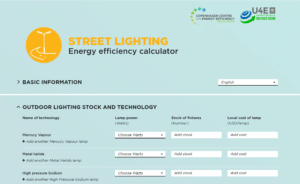The Copenhagen Centre on Energy Efficiency (C2E2) and the United Nations Environment Programme United for Efficiency (U4E) initiative have partnered to jointly to launch a new online assessment tool to accelerate the transition to much more energy-efficient, digitally-connected and controlled street lighting globally.
 Public lighting infrastructure is key for citizens’ health and wellbeing for safety reasons, the assurance of smooth and safe traffic flows and the overall quality of life. It also presents opportunities for other features that position street lighting as a potential strategic asset for the next step to smart cities, such as Wi-Fi connectivity, electrification for other services such as electric vehicles, etc. Worldwide, there are around 320 million street lighting poles, which can represent up to 40% of the electricity bill at the municipal level. The switch to already available, more intelligent, energy-efficient light-emitting diode (LED) solutions can help developing and emerging economy countries to generate annual electricity savings of 40% to 60% and represents a simple yet effective way to pursue greenhouse gas emissions mitigation at the same time. As a result of falling LED costs and quality improvements, payback periods of lower than three years can be achieved accounting for the initial investment and the generation of enough savings to fully cover the cost of lamp replacement. By incorporating higher performance, controls and efficiency into existing and planned lighting infrastructure systems, costs can be controlled, the quality of service can be improved, and lighting access expanded without necessarily adding to the cost.
Public lighting infrastructure is key for citizens’ health and wellbeing for safety reasons, the assurance of smooth and safe traffic flows and the overall quality of life. It also presents opportunities for other features that position street lighting as a potential strategic asset for the next step to smart cities, such as Wi-Fi connectivity, electrification for other services such as electric vehicles, etc. Worldwide, there are around 320 million street lighting poles, which can represent up to 40% of the electricity bill at the municipal level. The switch to already available, more intelligent, energy-efficient light-emitting diode (LED) solutions can help developing and emerging economy countries to generate annual electricity savings of 40% to 60% and represents a simple yet effective way to pursue greenhouse gas emissions mitigation at the same time. As a result of falling LED costs and quality improvements, payback periods of lower than three years can be achieved accounting for the initial investment and the generation of enough savings to fully cover the cost of lamp replacement. By incorporating higher performance, controls and efficiency into existing and planned lighting infrastructure systems, costs can be controlled, the quality of service can be improved, and lighting access expanded without necessarily adding to the cost.
Nonetheless, despite the multiple benefits of modern high performance LED street lighting, the average LED penetration at a global level is still below 15%. Given the global context, the large LED street lighting opportunity and country requirements, C2E2 and U4E have partnered to launch a new online assessment tool to accelerate the transition to much more energy efficient, digitally connected and controlled street lighting globally.
The Street Lighting Energy Efficient Calculator estimates and analyses the potential energy and CO2 savings enabling a straightforward cost benefit overview for any locality, city or country based on their current street lighting system.
The online tool quantifies the energy, financial and climate saving potential that can be achieved from the transition from existing older street lighting technologies to intelligent, controlled, energy-efficient LED systems. The aim of the Street Lighting Energy Efficient Calculator is to provide local government decision-makers with a detailed understanding of the specific savings and financial opportunities in their municipality/cities. It has been designed as a self-assessment savings tool enabling municipalities to complete a number of key local data inputs on the current status of their locality/city public lighting system generate a straightforward and short report with the results of the analysis (available in different languages) that can be downloaded after data input. The report includes annual electricity, financial and CO2 emissions savings from the conversion to modern, higher performance, lower maintenance, energy-efficient LED technology, as well as information on the estimated investment cost, the payback period and straightforward graphics to illustrate the results and benefits.
The Street Lighting Energy Efficient Calculator is available on the Copenhagen Centre on Energy Efficiency website. To access the tool and find out more about the energy, environmental and financial potential benefits from the switch to LED street lighting, click here.
To directly access the Street Lighting Energy Efficient Calculator, and a short demonstration video on how to use the tool, click here.


Leave a Reply